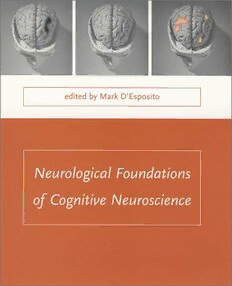
Neurological Foundations of Cognitive Neuroscience PDF
Preview Neurological Foundations of Cognitive Neuroscience
NEUROLOGICALFOUNDATIONS OF COGNITIVE NEUROSCIENCE Issues in Clinical and Cognitive Neuropsychology Jordan Grafman, series editor Neurological Foundations of Cognitive Neuroscience Mark D’Esposito, editor, 2003 The Parallel Brain: The Cognitive Neuroscience of the Corpus Callosum Eran Zaidel and Marco Iacoboni, editors, 2002 Gateway to Memory: An Introduction to Neural Network Modeling of the Hippocampus and Learning Mark A. Gluck and Catherine E. Myers, 2001 Patient-Based Approaches to Cognitive Neuroscience Martha J. Farah and Todd E. Feinberg, editors, 2000 NEUROLOGICALFOUNDATIONS OF COGNITIVE NEUROSCIENCE edited by Mark D’Esposito ABradford Book The MITPress Cambridge, Massachusetts London, England ©2003 Massachusetts Institute of Technology All rights reserved. No part of this book may be reproduced in any form by any electronic or mechanical means (including photocopying, recording, or information storage and retrieval) without permission in writing from the publisher. This book was set in Times Roman by SNPBest-set Typesetter Ltd., Hong Kong and was printed and bound in the United States of America. Library of Congress Cataloging-in-Publication Data Neurological foundations of cognitive neuroscience / edited by Mark D’Esposito. p. cm.—(Issues in clinical and cognitive neuropsychology) “ABradford book.” Includes bibliographical references and index. ISBN 0-262-04209-6 (hc. : alk. paper) 1. Cognition disorders. 2. Cognitive neuroscience. I. D’Esposito, Mark. II. Series. RC533.C64 N475 2002 616.8—dc21 2002021912 10 9 8 7 6 5 4 3 2 1 To Judy, Zoe, and Zack This page intentionally left blank Contents Preface ix 1 Neglect: ADisorderof Spatial Attention 1 Anjan Chatterjee 2 Bálint’s Syndrome: ADisorderof Visual Cognition 27 Robert Rafal 3 Amnesia: ADisorderof Episodic Memory 41 Michael S. Mega 4 Semantic Dementia:ADisorderof Semantic Memory 67 John R. Hodges 5 Topographical Disorientation: ADisorderof Way-Finding Ability 89 Geoffrey K. Aguirre 6 Acquired Dyslexia: ADisorderof Reading 109 H. Branch Coslett 7 Acalculia: ADisorderof Numerical Cognition 129 Darren R. Gitelman 8 Transcortical MotorAphasia: ADisorderof Language Production 165 Michael P. Alexander 9 Wernicke Aphasia: ADisorderof Central Language Processing 175 Jeffrey R. Binder 10 Apraxia: ADisorderof Motor Control 239 Scott Grafton 11 Lateral Prefrontal Syndrome: ADisorderof Executive Control 259 Robert T. Knight and Mark D’Esposito Contributors 281 Index 283 This page intentionally left blank Preface It is an exciting time for the discipline of cogni- and functional neuroimaging studies of both normal tive neuroscience. In the past 10 years we have individuals and neurological patients—aimed at witnessed an explosion in the development and understanding the neural mechanisms underlying advancement of methods that allow us to precisely the cognitive functions affected in each particular examine the neural mechanisms underlying cog- clinical syndrome. In many chapters, there are con- nitive processes. Functional magnetic resonance flicting data derived from different methodologies, imaging, for example, has provided markedly im- and the authors have tried to reconcile these differ- proved spatial and temporal resolution of brain ences. Often these attempts at understanding how structure and function, which has led to answers to these data may be convergent, rather than divergent, new questions, and the reexamination of old ques- has shed new light on the cognitive mechanisms tions. However, in my opinion, the explosive impact being explored. that functional neuroimaging has had on cogni- The goal of preparing this book was not to simply tive neuroscience may in some ways be responsible describe clinical neurobehavioral syndromes. for moving us away from our roots—the study of Such descriptions can be found in many excellent patients with brain damage as a window into the textbooks of behavioral and cognitive neurology. functioning of the normal brain. Thus, my motiva- Nor was the goal to provide a primer in cognitive tion for creating this book was to provide a collec- neuroscience. The goal of this book is to consider tion of chapters that would highlight the interface normal cognitive processes in the context of between the study of patients with cognitive patients with cognitive deficits. Each of the clinical deficits and the study of cognition in normal indi- syndromes in this book is markedly heterogeneous viduals. It is my hope that reading these chapters and the range of symptoms varies widely across will remind us as students of cognitive neuro- patients. As Anjan Chatterjee aptly states in his science that research aimed at understanding the chapter on the neglect syndrome: “This hetero- function of the normal brain can be guided by geneity would be cause for alarm if the goal of studying the abnormal brain. The incredible insight neglect research was to establish a unified and derived from patients with neurological and psy- comprehensive theory of the clinical syndrome. chiatric disorders provided the foundation for the However, when neglect is used to understand the discipline of cognitive neuroscience and should organization of spatial attention and representation, continue to be an important methodological tool then the behavioral heterogeneity is actually critical in future studies. to its use as an investigative tool.” These words Each chapter in this book was written by a neu- capture perfectly my intent for this book. rologist who also practices cognitive neuroscience. Many neurologists in training and in practice Each chapter begins with a description of a case lack exposure to cognitive neuroscience. Similarly, report, often a patient seen by the author, and many newly trained cognitive neuroscientists describes the symptoms seen in this patient, laying lack exposure to the rich history of investigations the foundation for the cognitive processes to be of brain–behavior relationships in neurological explored. After the clinical description, the authors patients. I am optimistic that this book will serve have provided a historical background about what both groups well. It is a privilege to have assembled we have learned about these particular neurobe- an outstanding group of neurologists and cognitive havioral syndromes through clinical observation neuroscientists to present their unique perspective and neuropsychological investigation. Each chapter on the physical basis of the human mind. then explores investigations using a variety of methods—single-unit electrophysiological record- ing in awake-behaving monkeys, behavioral studies of normal healthy subjects, event-related potential
